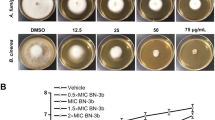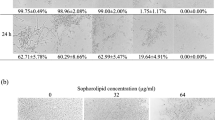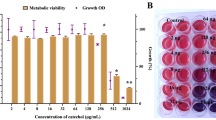Abstract
Berberine hydrochloride (BH), an active component of Coptis chinensis and other plant taxa, has broad antimicrobial activity and may be useful for the treatment of Candida infections. In this study, the mechanisms underlying the inhibitory effect of BH against Candida albicans were evaluated, with a focus on the high-osmolarity glycerol mitogen-activated protein kinase (HOG-MAPK) pathway, which regulates multiple physiological functions. BH (256 and 64 μg ml−1) significantly increased intracellular glycerol and ROS levels in C. albicans, inhibited germ tube and hyphal formation, and increased chitin and β−1,3-glucan exposure on the cell wall. The inhibitory effect of BH was positively correlated with its concentration, and the inhibitory effect of 256 μg ml−1 BH was greater than that of 4 μg ml−1 fluconazole (FLC). Furthermore, RT-PCR analysis showed that 256 and 64 μg ml−1 BH altered the HOG-MAPK pathway in C. albicans. In particular, the upregulation of the core genes, SLN1, SSK2, HOG1, and PBS2 may affect the expression of key downstream factors related to glycerol synthesis and osmotic pressure (GPD1), ROS accumulation (ATP11 and SOD2), germ tube and hyphal formation (HWP1), and cell wall integrity (CHS3 and GSC1). BH affects multiple biological processes in C. albicans; thus, it can be an effective alternative to conventional azole antifungal agents.
This is a preview of subscription content, access via your institution
Access options
Subscribe to this journal
Receive 12 print issues and online access
$259.00 per year
only $21.58 per issue
Buy this article
- Purchase on Springer Link
- Instant access to full article PDF
Prices may be subject to local taxes which are calculated during checkout





Similar content being viewed by others
References
Rauseo AM, Coler-Reilly A, Larson L, Spec A. Hope on the horizon: novel fungal treatments in development. Open Forum Infect Dis. 2020;7:ofaa016.
Liu DQ, Chen SP, Sun J, Wang XM, Chen N, Zhou YQ, et al. Berberine protects against ischemia-reperfusion injury: a review of evidence from animal models and clinical studies. Pharm Res. 2019;148:104385.
Imenshahidi M, Hosseinzadeh H. Berberine and barberry (Berberis vulgaris): a clinical review. Phytother Res. 2019;33:504–23.
Tillhon M, Ortiz LMG, Lombardi P, Scovassi AI. Berberine: new perspectives for old remedies. Biochem Pharmacol. 2012;84:1260–7.
Horie T, Tatebayashi K, Yamada R, Saito H. Phosphorylated Ssk1 prevents unphosphorylated Ssk1 from activating the Ssk2 mitogen-activated protein kinase in the yeast high-osmolarity glycerol osmoregulatory pathway. Mol Cell Biol. 2008;28:5172–83.
Cheetham J, Smith DA, da Silva DA, Doris KS, Patterson MJ, Bruce CR, et al. A single MAPKKK regulates the Hog1 MAPK pathway in the pathogenic fungus Candida albicans. Mol Biol Cell. 2007;18:4603–14.
Enjalbert B, Smith DA, Cornell MJ, Alam I, Nicholls S, Brown AJP, et al. Role of the Hog1 stress-activated protein kinase in the global transcriptional response to stress in the fungal pathogen Candida albicans. Mol Biol Cell. 2006;17:1018–32.
Román E, Correia I, Prieto D, Alonso R, Pla J. The HOG MAPK pathway in Candida albicans: more than an osmosensing pathway. Int Microbiol. 2020;23:23–9.
Liu S, Chen C. Advances in MAPK signaling pathway in pathogenic fungi. Hunan Agric Sci. 2017;11:119–22.
Dunayevich P, Baltanás R, Clemente JA, Couto A, Sapochnik D, Vasen G, et al. Heat-stress triggers MAPK crosstalk to turn on the hyperosmotic response pathway. Sci Rep. 2018;8:15168.
Correia I, Alonso-Monge R, Pla J. The Hog1 MAP kinase promotes the recovery from cell cycle arrest induced by hydrogen peroxide in Candida albicans. Front Microbiol. 2017;6:2133.
Lee YM, Kim E, An J, Lee Y, Choi E, Choi W, et al. Dissection of the HOG pathway activated by hydrogen peroxide in Saccharomyces cerevisiae. Environ Microbiol. 2017;19:584–97.
Su C, Lu Y, Liu H. Reduced TOR signaling sustains hyphal development in Candida albicans by lowering Hog1 basal activity. Mol Biol Cell. 2013;24:385–97.
Alonso-Monge R, Carvaihlo S, Nombela C, Rial E, Pla J. The Hog1 MAP kinase controls respiratory metabolism in the fungal pathogen Candida albicans. Microbiol. 2009;155:413–23.
Morales-Menchén A, Navarro-García F, Guirao-Abad JP, Román E, Prieto D. Coman IV, et al. Non-canonical activities of Hog1 control sensitivity of Candida albicans to killer toxins from debaryomyces hansenii. Front Cell Infect Microbiol. 2018;8:135.
Hu TL, Yun Y, Xu ZQ, Duan QJ, Shao J, Wang TM, et al. Butyl alcohol extract of Baitouweng decoction inhibits Candida albicans cell membrane. J Chin Mater Med. 2017;42:3185–90.
Saibabu V, Fatima Z, Ahmad K, Khan LA, Hameed S. Octyl gallate triggers dysfunctional mitochondria leading to ROS driven membrane damage and metabolic inflexibility along with attenuated virulence in Candida albicans. Med Mycol. 2020;58:380–92.
Zhong H, Hu DD, Hu GH, Su J, Bi S, Zhang ZE, et al. Activity of Sanguinarine against Candida albicans biofilms. Antimicrob Agents Chemother. 2017;61:e02259–16.
Lee HS, Kim Y. Paeonia lactiflora inhibits cell wall synthesis and triggers membrane depolarization in Candida albicans. J Microbiol Biotechnol. 2017;27:395–404.
CLSI. Reference method for broth dilution antifungal susceptibility testing of yeasts. 4th ed. Wayne (PA): Clinical and Laboratory Standards Institute; 2017.
Ding T, Wang SF, Zhang XY, Zai WJ, Fan JJ, Chen W, et al. Kidney protection effects of dihydroquercetin on diabetic nephropathy through suppressing ROS and NLRP3 inflammasome. Phytomedicine. 2018;41:45–53.
Afri M, Frimer AA, Cohen Y. Active oxygen chemistry within the liposomal bilayer. Part IV: locating 2ʼ,7ʼ-dichlorofluorescein (DCF), 2ʼ,7ʼ-dichlorodihydrofluorescein (DCFH) and 2ʼ,7ʼ-dichlorodihydrofluorescein diacetate (DCFH-DA) in the lipid bilayer. Chem Phys Lipids. 2004;131:123–33.
Özdemir A, Altıntop MD, Sever B, Gençer HK, Kapkaç HA, Atlı O, et al. A new series of pyrrole-based chalcones: synthesis and evaluation of antimicrobial activity, cytotoxicity, and genotoxicity. Molecules. 2017;22:E2112.
Nakamura A, Takigawa K, Kurishita Y, Kuwata K, Ishida M, Shimoda Y, et al. Hoechst tagging: a modular strategy to design synthetic fluorescent probes for live-cell nucleus imaging. Chem Commun. 2014;50:6149–52.
Zhao XY, Guo G, Su PP, Yang LJ, Zhu LJ, Tian ZQ, et al. Inhibitory effect of housefly antimicrobial peptide AMP-17 on hyphae of Candida albicans. Microbiol China. 2017;12:1–15.
Li Y, Sun H, Zhu X, Bian C, Wang YC, Si S. Identification of new antifungal agents targeting chitin synthesis by a chemical-genetic method. Molecules. 2019;24:E3155.
Liu YF, Tang QJ, Zhang JS, Zhou S, Wang CG, Yang Y, et al. Determination of β-1,3-glucan content and analysis of polysaccharide composition from Ganoderma lingzhi extract. Mycosystema. 2018;37:1525–31.
Haque F, Alfatah M, Ganesan K, Bhattacharyya MS. Inhibitory effect of sophorolipid on Candida albicans biofilm formation and hyphal Growth. Sci Rep. 2016;6:23575.
Mancuso R, Chinnici J, Tsou C, Busarajan S, Munnangi R, Maddi A. Functions of Candida albicans cell wall glycosidases Dfg5p and Dcw1p in biofilm formation and HOG MAPK pathway. PeerJ. 2018;6:e5685.
Guerra-Moreno A, Ang J, Welsch H, Jochem M, Hanna J. Regulation of the unfolded protein response in yeast by oxidative stress. FEBS Lett. 2019;593:1080–88.
Liu NN, Uppulur P, Broggi A, Besold A, Ryman K, Kambara H, et al. Intersection of phosphate transport, oxidative stress and TOR signalling in Candida albicans virulence. PLoS Pathog. 2018;14:e1007076.
Hohmann S. An integrated view on a eukaryotic osmoregulation system. Curr Genet. 2015;61:373–82.
Vogt S, Rhiel A, Weber P, Ramzan R. Revisiting Kadenbach: electron flux rate through cytochrome c-oxidase determines the ATP-inhibitory effect and subsequent production of ROS. Bioessays. 2016;38:556–67.
Wang ZG, Ackerman SH. Identification of functional domains in Atp11p.Protein required for assembly of the mitochondrial F1-ATPase in yeast. J Biol Chem. 1996;271:4887–94.
Lefebvre-Legendre L, Salin B, Schaëffer J, Brèthes D, Dautant A, Ackerman SH, et al. Failure to assemble the alpha 3 beta 3 subcomplex of the ATP synthase leads to accumulation of the alpha and beta subunits within inclusion bodies and the loss of mitochondrial cristae in Saccharomyces cerevisiae. J Biol Chem. 2005;280:18386–92.
Netto LE, Antunes F. The roles of peroxiredoxin and thioredoxin in hydrogen peroxide sensing and in signal transduction. Mol Cells. 2016;39:65–71.
Yan L, Li M, Cao Y, Gao P, Cao Y, Wang Y, et al. The alternative oxidase of Candida albicans causes reduced fluconazole susceptibility. J Antimicrob Chemother. 2009;64:764–73.
Lu Y, Su C, Liu H. Candida albicans hyphal initiation and elongation. Trends Microbiol. 2014;22:707–14.
Kim S, Nguyen QB, Wolyniak MJ, Frechette G, Lehman CR, Fox BK, et al. Release of transcriptional repression through the HCR promoter region confers uniform expression of HWP1 on surfaces of Candida albicans germ tubes. PLoS ONE. 2018;13:e0192260.
Lee JH, Kim YG, Khadke SK, Yamano A, Watanabe A, Lee J. Inhibition of biofilm formation by Candida albicans and polymicrobial microorganisms by nepodin via hyphal-growth suppression. ACS Infect Dis. 2019;5:1177–87.
Lee JH, Kim YG, Choi P, Ham J, Park JG, Lee J. Antibiofilm and antivirulence activities of 6-gingerol and 6-shogaol against Candida albicans due to hyphal inhibition. Front Cell Infect Microbiol. 2018;8:299.
Cullen PJ, Edgerton M. Unmasking fungal pathogens by studying MAPK-dependent cell wall regulation in Candida albicans. Virulence. 2016;7:502–5.
Eggimann P, Garbino J, Pittet D. Management of Candida species infections in critically ill patients. Lancet Infect Dis. 2003;3:772–85.
Knafler HC, Smaczynska-de RII, Walker LA, Lee KK, Gow NAR, Ayscough KR. AP-2-dependent endocytic recycling of the chitin synthase Chs3 regulates polarized growth in Candida albicans. mBio. 2019;10:e02421–18.
Ugbogu EA, Wang K, Schweizer LM, Schweizer M. Metabolic gene products have evolved to interact with the cell wall integrity pathway in Saccharomyces cerevisiae. FEMS Yeast Res. 2016;16:fow092.
Wang O, Gellynck X, Verbeke W. Chinese consumers and European beer: associations between attribute importance, socio-demographics, and consumption. Appetite. 2017;108:416–24.
Orlean P. Architecture and biosynthesis of the Saccharomyces cerevisiae cell wall. Genetics. 2012;192:775–818.
Benedetti VP, Savi DC, Aluizio R, Adamoski D, Kava V, Galli-Terasawa LV, et al. ERG11 gene polymorphisms and susceptibility to fluconazole in Candida isolates from diabetic and kidney transplant patients. Rev Soc Bras Med Trop. 2019;52:e20180473.
Zorić N, Kosalec I, Tomić S, Bobnjarić I, Jug M, Vlainić T, et al. Membrane of Candida albicans as a target of berberine. BMC Complement Alter Med. 2017;17:268.
Guirao-Abad JP, Sánchez-Fresneda R, Román E, Pla J, Argüelles JC, Alonso-Monge R. The MAPK Hog1 mediates the response to amphotericin B in Candida albicans. Fungal Genet Biol. 2020;136:103302.
Wang YT, Liu JY, Shi C, Zhao JT, Xiang MJ. Knocking out ERG3 gene of Candida albicans and Iits effect on drug resistance. J Shanghai Jiaotong Univ (Med Sci). 2020;40:163–70.
Acknowledgements
This work was supported by the Health Commission of Sichuan Province, People’s Republic of China (20PJ163), and the “Xinglin Scholar” Scientific Research Project of Chengdu University of TCM (JSZX2018006). We would like to thank Editage [www.editage.cn] for English language editing.
Author information
Authors and Affiliations
Contributions
X.H. and Y.L. conceived and designed the research. X.H. and Y.Y. performed most of the experiments. J.Y. and J.S. contributed to reagents, data analysis, and results in interpretation with the assistance of Z.S. and D.L. X.H. wrote the initial paper and Y.L. revised the paper. All authors approved the manuscript for publication.
Corresponding author
Ethics declarations
Conflict of interest
The authors declare no competing interests.
Additional information
Publisher’s note Springer Nature remains neutral with regard to jurisdictional claims in published maps and institutional affiliations.
Rights and permissions
About this article
Cite this article
Huang, X., Yi, Y., Yong, J. et al. Inhibitory effect of berberine hydrochloride against Candida albicans and the role of the HOG-MAPK pathway. J Antibiot 74, 807–816 (2021). https://doi.org/10.1038/s41429-021-00463-w
Received:
Revised:
Accepted:
Published:
Issue Date:
DOI: https://doi.org/10.1038/s41429-021-00463-w
This article is cited by
-
The potential role of plant secondary metabolites on antifungal and immunomodulatory effect
Applied Microbiology and Biotechnology (2023)
-
Oxidative stress response pathways in fungi
Cellular and Molecular Life Sciences (2022)
-
Identification of chitin synthase activator in Aspergillus niger and its application in citric acid fermentation
Applied Microbiology and Biotechnology (2022)



